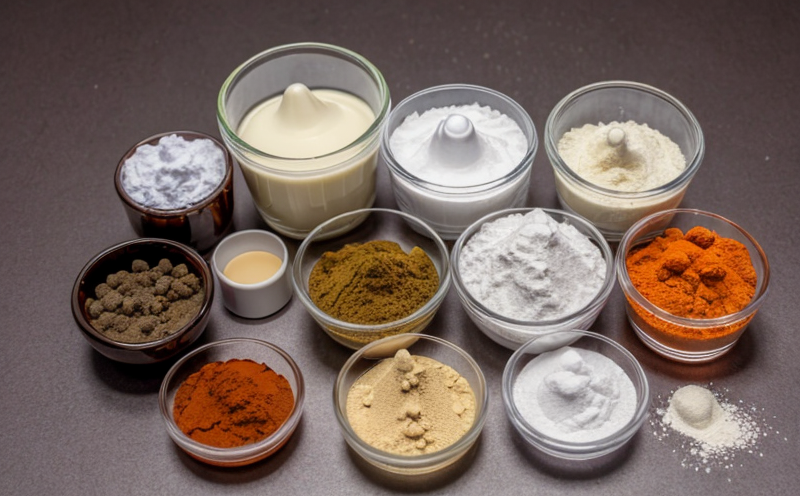TGA Thermal Stability Testing
In the pharmaceutical industry, thermal stability testing is crucial to ensure that excipients and formulation ingredients remain stable under various environmental conditions. This testing method evaluates how materials behave when subjected to heat. The technique used for this purpose is Thermogravimetric Analysis (TGA), which measures the changes in mass of a sample as it undergoes heating or cooling.
The primary objective of TGA thermal stability testing is to determine the temperature at which excipients and other formulation ingredients begin to degrade. This information is critical for drug product development, ensuring that formulations meet regulatory requirements and perform consistently across different environments and storage conditions.
Thermogravimetric analysis involves subjecting a sample to a controlled heating or cooling program in an inert atmosphere or under specific gas conditions. The temperature ramp rate can vary depending on the material being tested, ranging from slow (1–2°C/min) for delicate compounds to fast (50°C/min) for more robust materials.
During the test, a precise balance monitors any changes in mass as the sample is heated or cooled. The resulting data provides valuable insights into the thermal stability of the excipients and formulation ingredients used in pharmaceutical products. This information helps ensure that these components remain stable throughout manufacturing processes and during product storage.
The accuracy and precision of TGA testing are paramount, especially given the stringent requirements of regulatory bodies like the Therapeutic Goods Administration (TGA) in Australia. Compliance with international standards such as ISO 11358-2 is essential to ensure that test results are reliable and reproducible.
Thermogravimetric analysis can also provide additional information about the thermal decomposition products of a material, which may include gases or volatile compounds released during heating. This data is crucial for understanding not only the stability but also the potential side effects of excipients in pharmaceutical formulations.
Scope and Methodology
The scope of TGA thermal stability testing encompasses a wide range of excipients and formulation ingredients used in pharmaceutical products. These materials are crucial for ensuring the efficacy, safety, and quality of drugs. The methodology involves several key steps:
- Sample Selection: Careful selection of the sample is essential to ensure that it accurately represents the excipient or formulation ingredient being tested.
- Preparation: Samples are prepared according to standard operating procedures, which may include grinding, drying, or other treatment steps depending on the material's properties.
- Instrument Setup: The TGA instrument is calibrated and configured for the specific test conditions. This includes setting the temperature ramp rate, atmosphere, and heating/cooling profiles.
- Data Collection: The sample undergoes a controlled heating or cooling process while mass changes are continuously monitored.
- Analysis and Reporting: The collected data is analyzed to determine the onset temperature of weight loss, the amount of degradation, and any other relevant parameters. A detailed report is prepared for review by quality managers, compliance officers, and R&D engineers.
The methodology ensures that all tests are conducted under controlled conditions, allowing for accurate and reliable results. Compliance with international standards such as ISO 11358-2 guarantees the consistency and accuracy of these tests.
International Acceptance and Recognition
- Australia: TGA thermal stability testing is widely recognized by the Therapeutic Goods Administration (TGA), which mandates this type of analysis for ensuring that pharmaceutical products meet strict quality standards.
- United States: In the United States, the Food and Drug Administration (FDA) also emphasizes the importance of TGA thermal stability testing in drug product development. Compliance with USP General Chapters ensures that tests are conducted according to recognized protocols.
- Europe: Regulatory bodies across Europe, including the European Medicines Agency (EMA), require pharmaceutical companies to conduct TGA thermal stability testing as part of their quality assurance processes.
The acceptance and recognition of this testing method extend beyond national borders. Many international standards organizations, such as ISO and ASTM, provide guidelines for conducting TGA tests that are widely accepted by regulatory agencies worldwide.
Environmental and Sustainability Contributions
- Eco-friendly Processes: By ensuring the stability of excipients and formulation ingredients, TGA testing helps minimize waste in pharmaceutical manufacturing processes. Stable materials reduce the need for rework or replacement, leading to more efficient production.
- Reduced Waste: Accurate thermal stability testing allows manufacturers to optimize storage conditions, reducing the risk of degradation and ensuring that products remain viable over their shelf lives.
- Energy Efficiency: Understanding the thermal properties of excipients enables better control of heating processes, potentially leading to more efficient energy use in manufacturing facilities.
The pharmaceutical industry is increasingly focused on sustainability and environmental responsibility. TGA testing plays a vital role in this effort by providing data that helps reduce waste, optimize resource usage, and improve overall efficiency.





